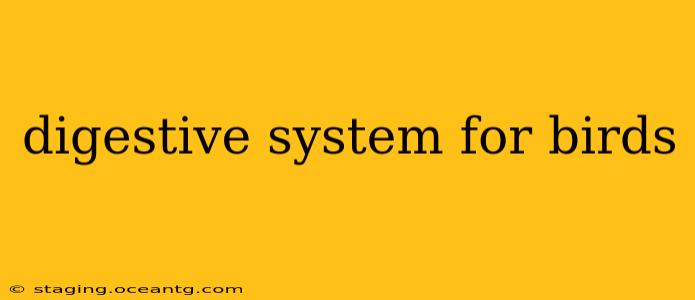Birds, with their incredible diversity and adaptability, possess a digestive system uniquely suited to their varied diets and high metabolic rates. Understanding how a bird's digestive system works reveals fascinating adaptations that allow them to efficiently extract nutrients from a wide range of food sources, from seeds and insects to nectar and fish. This article explores the intricacies of avian digestion, addressing common questions and providing a comprehensive overview.
What are the main parts of a bird's digestive system?
The avian digestive system differs significantly from that of mammals. It's a streamlined, efficient machine optimized for rapid processing of food. Key components include:
-
Beak and Mouth: Birds lack teeth, so initial food breakdown relies on the beak for tearing, cracking, and manipulating food items. Some species have specialized beaks reflecting their diet – think of the strong, hooked beak of a hawk versus the long, slender beak of a hummingbird. Saliva, while present, plays a less significant role in digestion than in mammals.
-
Esophagus: A muscular tube connecting the mouth to the crop and stomach. It allows for the passage of food.
-
Crop: A pouch-like enlargement of the esophagus, primarily for food storage and temporary softening. This is particularly important for birds that consume large quantities of food quickly, allowing for gradual digestion later.
-
Proventriculus (Glandular Stomach): The first part of the stomach, it secretes digestive enzymes like pepsin and hydrochloric acid, beginning the chemical breakdown of proteins.
-
Gizzard (Muscular Stomach): A thick-walled, muscular organ containing grit or small stones. These stones, ingested by the bird, act as millstones, grinding food into smaller particles, enhancing digestion. The gizzard's powerful contractions further break down food mechanically.
-
Small Intestine: The primary site of nutrient absorption. Digested food passes through the small intestine, where nutrients are absorbed into the bloodstream.
-
Large Intestine (Cloaca): A short, relatively simple structure where water is absorbed from undigested material. Waste products, along with uric acid (the main excretory product of birds), are eliminated through the cloaca, a common chamber for the digestive, urinary, and reproductive tracts.
How does a bird's digestive system differ from a human's?
The most striking differences lie in the presence of a crop and gizzard, the absence of teeth, and the efficiency of the system. Human digestion involves a more complex stomach and longer intestinal tract. Birds’ high metabolic rates necessitate faster processing, minimizing food storage time. The cloaca is also unique to birds and reptiles, combining excretory and reproductive functions.
What is the role of grit in a bird's digestive system?
Grit acts as a crucial component in the gizzard, acting as natural "teeth" to grind food. Birds intentionally consume grit to aid in the mechanical breakdown of tough food items like seeds and insects, increasing the surface area for enzymatic action in the subsequent digestive stages. Without grit, digestion would be significantly less efficient.
How long does it take for food to pass through a bird's digestive system?
The time it takes for food to pass through a bird’s digestive system varies considerably depending on the species, diet, and type of food consumed. Generally, it ranges from a few hours to a couple of days. Smaller birds tend to process food faster than larger birds.
What are some common digestive problems in birds?
Various factors can affect a bird's digestive system, leading to issues like:
- Crop impaction: A blockage in the crop, often due to indigestible materials.
- Gastritis: Inflammation of the stomach lining.
- Parasites: Internal parasites can disrupt digestion and nutrient absorption.
- Nutritional deficiencies: Inadequate diet can lead to digestive problems.
These issues often require veterinary intervention.
How can I help ensure my pet bird has a healthy digestive system?
Providing a balanced diet appropriate for your bird's species is crucial. Ensure access to fresh water and avoid feeding indigestible materials. Regular veterinary check-ups can help detect and address potential problems early on. Observing your bird's droppings can also provide insights into its digestive health. Changes in frequency, consistency, or color warrant attention.
This comprehensive exploration of the avian digestive system highlights the remarkable adaptations that allow birds to thrive on diverse diets. The efficiency and specialized structures within this system are testaments to the evolutionary success of this fascinating group of animals. Remember that this information is for general knowledge and should not replace professional veterinary advice for pet birds.
